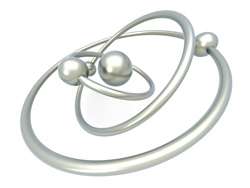Describing particle coupling in condensed matter

The seemingly countless recent discoveries and predictions of particle physics are spurred by increasingly sophisticated mathematical theories and predictions. European researchers made important contributions to descriptions of quantum particle interactions heretofore technically inaccessible with potential impact on a number of fields in physics and mathematics.
By the mid 1960s, scientists had realised that the simple model of all matter being composed of protons, electrons and neutrons could not explain the plethora of new particles being discovered.
Most scientists now agree that the so-called Standard Model of Particle Physics with its roots in those discoveries is currently the best description of the Universe.
According to the Standard Model, everything in the Universe is described by 12 fundamental matter particles, collectively called fermions (six quarks and six leptons) and four fundamental force particles, collectively called bosons (among them the elusive Higgs boson), that govern them.
When it comes to matter particles, quarks exist only in groups whereas leptons can exist individually in nature. Quarks are held together by the ‘strong’ force particle (among the four fundamental forces) aptly called ‘gluon’.
Quantum chromodynamics (QCD) is the (guage field) theory of particle physics that describes the strong interactions of quarks and gluons.
Mathematical descriptions of strongly coupled gauge theories at finite density and low energy, such as those related to QCD, are currently inaccessible due to technical difficulties. However, they are of critical importance to fields from nuclear physics to condensed matter physics, where condensed matter includes systems in the solid and liquid phases as well as more exotic entities.
EU researchers working on the ‘Strongly coupled gauge theories at finite density’ (FD HOLOG) project set out to apply holographic techniques to study the regimes of gauge theories such as QCD that have not been previously described.
Scientists developed a new classification of certain gravitational systems allowing fast computation of transport coefficients (related to the kinetics of particle motion) particularly important in condensed matter systems such as the Bose-Einstein condensate, and demonstrated the first application to the physics of strange metals.
In addition, they studied dimensionally reduced large-N theories (reducing higher-dimension systems to lower-dimension ones more tractable mathematically) to construct relevant equations for QCD-like theories with one compactified direction and including boundary conditions on fermions.
FD HOLOG results could have important impact on a variety of fields in mathematics and particle physics related to coupling of particles at finite densities.
Provided by CORDIS

















